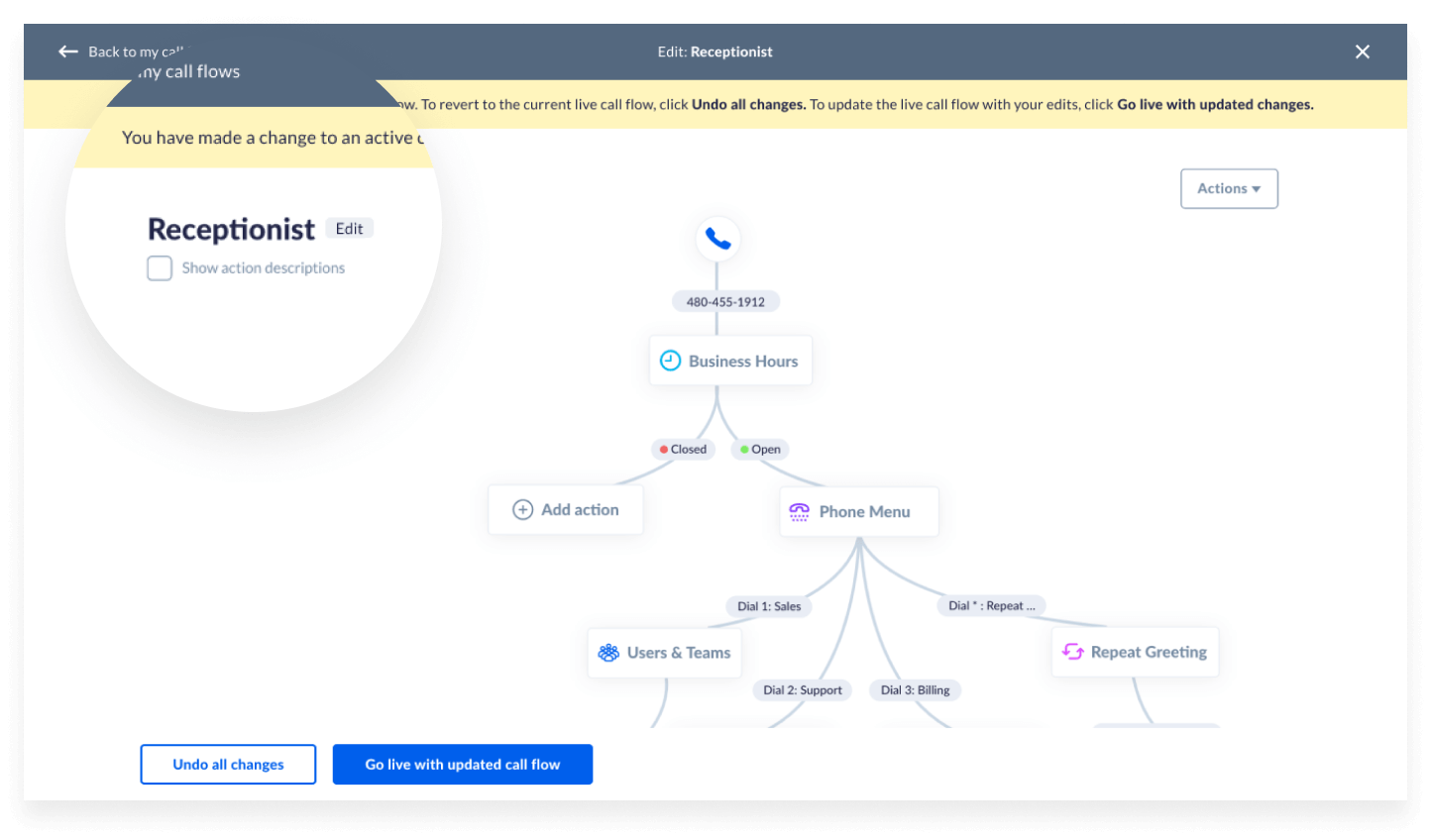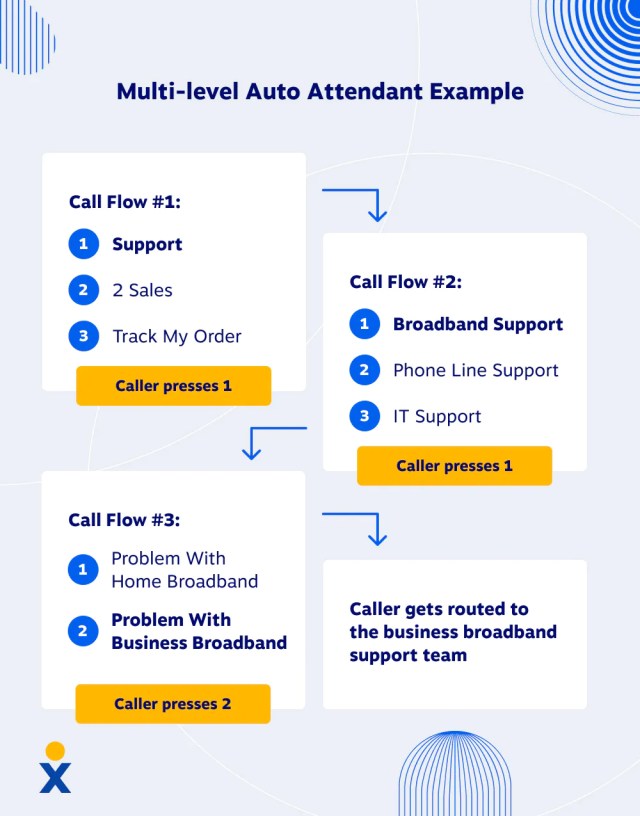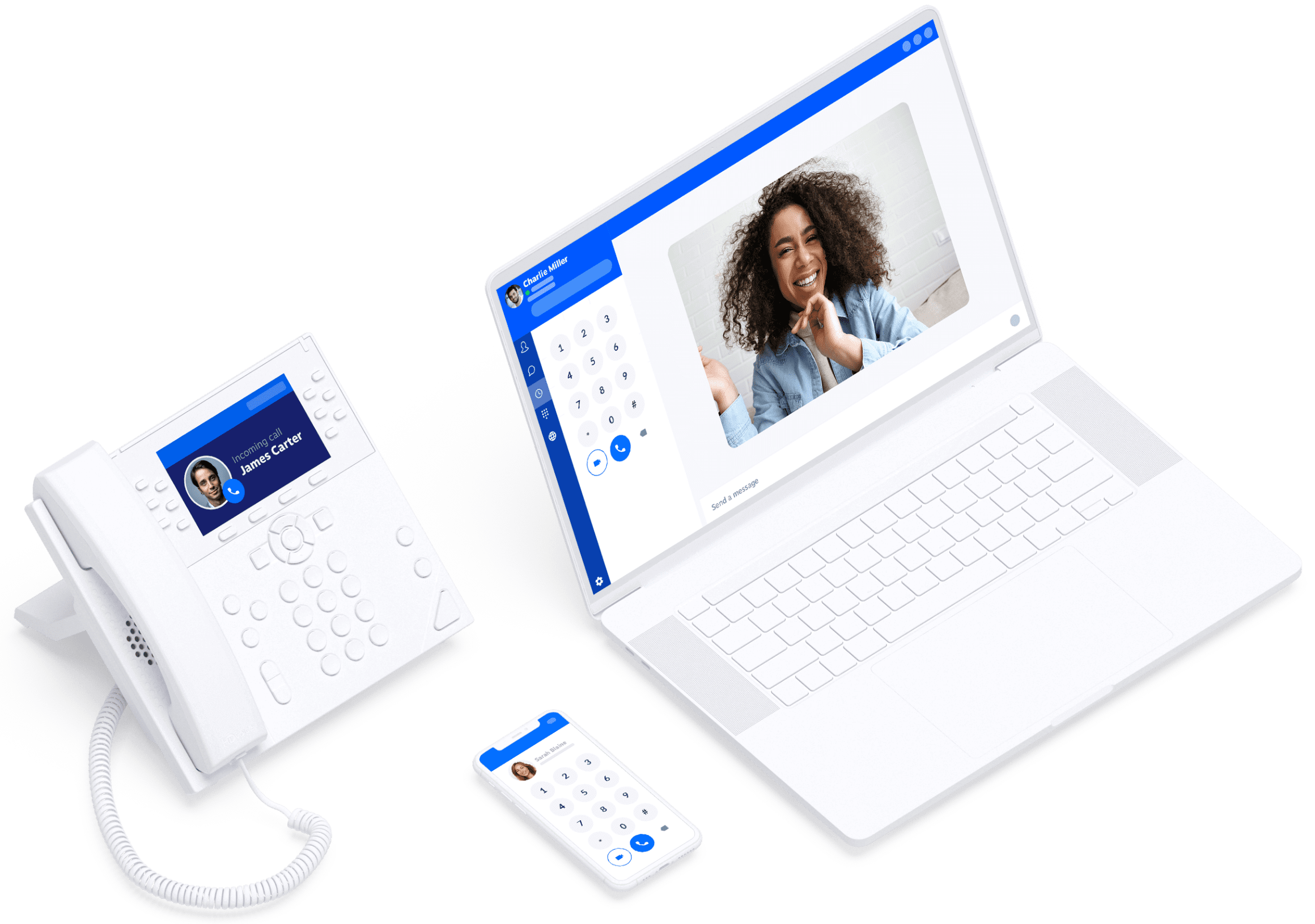Table of Contents
When a customer calls your company, will they reach the right person? Or will they give up halfway and dial a competitor instead?
This is where a phone tree proves its value, so it helps connect a large number of people with the department when they call your business phone number.
If you want a professional experience for incoming calls, you won’t have to spend tens of thousands of dollars on equipment, IT geniuses, or studying a complex owner’s manual.
We’ll explain everything you should know about an automated phone tree, including how it works, best practices, and helpful templates for setting one up successfully.
What Is a Phone Tree?
A phone tree is a feature that directs callers to different options or departments based on a caller’s input or selection. It’s often the first touchpoint in the customer’s experience when contacting a business.
It works by using pre-recorded voice prompts and touch-tone keypad responses to guide callers through a series of menu options. Based on the caller’s selection, the phone tree system routes the call to the corresponding department or individual within the organization.

A phone tree is also known as an auto attendant, virtual receptionist, or Interactive Voice Response (IVR). Overall, a phone tree facilitates the call routing process by automating the initial steps and ensuring callers are directed to the appropriate resources.
Historically, phone tree services date back to the late 1980s, consisting of dedicated switchboard operators, traditional phone tree circuits, and primitive PBX systems. Thankfully, due to modern VoIP solutions, it’s a lot more capable and easier to manage.
Benefits of Implementing a Phone Tree
- Fewer interruptions for staff: By automatically routing callers to the right person or department, a phone tree reduces unnecessary transfers or having to check for who is available to take a call.
- Deliver information faster: Phone trees can provide helpful messages for inbound calls 24/7. Even if your support or sales team isn’t available, a pre-recorded message can help outside of business hours.
- Enhance the customer experience: When set up properly, a phone tree can provide a guided path for customers for self-service or to reach the right agent the first time. Ultimately, it provides a better calling experience.
- Maintain a professional brand. A well-designed phone tree presents a professional brand to the callers, regardless of the company’s size. Whether you have two employees or 2,000, your phone system can project the image you want.
- Deflect spam calls: As businesses grow, staff are targets for spam or robocalls. Phone trees reject nuisance calls without anyone on your team being bothered.
- Improve customer care: phone trees assist with personalized customer care. With each menu option selected by a caller, you’re closer to understanding their intent and can intelligently route calls to an agent ready to help without repeating themselves.
- Optimized voicemail handling: When you don’t have a team that can answer incoming callers, asking callers to leave a voice message isn’t a bad option. This way, you can get a voicemail transcription in your email or SMS text message.
Best Practices for Designing an Effective Phone Tree
Designing your phone tree so it’s user-friendly and effective ensures a smooth journey for a large number of people. Will it be fit for every use case? No, but it’ll get the vast majority of callers where they need to go in real time.
Efficiency is doing things right; effectiveness is doing the right things.
Peter Drucker
Here are five best practices to follow to ensure your phone tree upholds your customer satisfaction goals:
1) Keep it simple
Menu options should be clear and concise. Avoid industry jargon, complex vocabulary, or long sentences. The easier it is for callers to understand their options, the more likely they’ll reach the department or person they need.
2) Limit phone tree options
While it’s important to cover all necessary departments or services, opt for multiple levels of a manual phone tree. This way, nested menu options are increasingly helpful to callers. Too many choices can overwhelm callers. Aim for no more than five options per level.

3) Offer a repeat option
Include a menu choice to let incoming callers repeat the menu options. Life happens, and people might miss the finer details between menu options. This prevents irrelevant calls from being routed to team members in error.
4) Provide a path to a live person
Despite how well-organized your phone tree might be, some callers prefer speaking to a human right away. Always provide an option to reach a live operator, preferably within the first level of options. Even if you don’t mention it in your voice menu, dialing 0 is a common way to reach a live person.
5) Update your call tree regularly
Consider refreshing your automated phone tree system a few times a year. Seasonal businesses should align with the trends around incoming call volume. Perhaps you hear from a call center team that they’re receiving misdirected phone calls. In that case, review and test your phone tree software.
Don’t forget that the purpose of an automated phone tree is to help customers and your team through automation. If your telephone tree is too cumbersome, it’ll be counterintuitive.
Helpful Phone Tree Templates for Small Businesses
Standard Phone Tree Template:
- Greeting: Welcome message and a brief introduction to the company.
- Options: Press 1 for Sales, Press 2 for Customer Support, Press 3 for Billing, and Press 4 for Other.
- Connect: Route the caller to the selected group of people within a department.
- After-hours message: If calling outside of business hours, provide information and options for leaving a message or contacting someone later.
Customer Support Phone Tree Template:
- Greeting: Welcome message and options for language choices.
- Options: Press 1 for Technical Support, Press 2 for Billing Inquiries, Press 3 for Order Status, Press 4 for Account Management, and Press 5 for Cancellations.
- Sub-options: Each department may have additional sub-options for specific products or services offered.
- Connect: route the caller to the appropriate call center agent skilled to handle the calls.
Sales Phone Tree Template:
- Greeting: Welcome message and special pricing offer (press 9 to hear more).
- Options: Press 1 for Sales, Press 2 for Support, Press 3 for Store Location and Hours, and Press 0 to speak with the operator.
- Connect: Route callers to the appropriate sales representative based on their selection and prequalify incoming callers based on interest in a special offer.
- Call transfer: If the representative is unavailable, offer to transfer the call or take a message.
- After the call, the sales representative should follow up with the lead promptly.
How to Get a Phone Tree for Your Business
A phone tree can be a game-changer for handling incoming calls and providing a seamless customer experience. It’s a telephony feature instrumental for business success.

The best way to get a phone tree for your company is to use a hosted VoIP phone system. With it, you get access to a lot more communication and collaboration features for the whole team:
- Unlimited nationwide calling: Nextiva offers unlimited calls across the United States and Canada, allowing businesses to stay connected without counting minutes, ever!
- Call recording: Automatically record calls by department, team, or individual. Act on these unfiltered customer experience insights to improve the business.
- Voicemail transcription: This feature transcribes voicemails and sends them to your email or text message for easy access and record-keeping.
- Call flows: Nextiva’s visual call flow feature directs incoming calls to the right person or department smoothly, improving the caller experience. It requires no code, and anyone can set it up.
- Video conferencing: Nextiva includes virtual meeting capabilities with its communication platform. Hop on a quick video call or host an all-hands meeting with ease.
- Mobile and desktop apps: Maintain privacy and keep the whole team connected with a unified mobile and desktop app.
- Advanced analytics: Gain valuable insights into your communication practices with Nextiva’s advanced analytics capabilities.
The best part is that you get all these advanced features for way less than the local telephone company. In fact, VoIP saves businesses up to 60% on their communications. Plus, you won’t need to pay for an extra Zoom license or conference calling service.
Explore your options with a no-obligation price quote. You’ll know the actual cost (and savings) when you chat with a business VoIP expert today.
Phone Tree FAQs
Yes, despite the rise of digital communication, phone trees are still widely in use across enterprises and smaller businesses.
The convenience and ability to handle large volumes of calls make phone trees an enduring and popular tool since they provide a cost-effective and efficient way to manage inbound calls, ensuring that callers can quickly connect with relevant departments.
Yes, phone trees can be highly effective when implemented correctly. A study by NN Group found that when customers seek help, 60% will call a company for help over using social media. This suggests that a phone call is the first step to resolving a customer’s concern.
They streamline call routing, reducing wait time and frustration for callers, and they can expedite customer service by facilitating more timely and targeted responses. They are particularly valuable for small businesses because they handle high call volumes, freeing up staff to handle more complex customer interactions.
However, the effectiveness of a phone tree greatly depends on its design and execution. It’s crucial that the menu options are concise, intuitive, and reflect the needs of the callers. Providing a direct route to speak with a live agent can significantly enhance caller satisfaction, as it offers a fallback option if the automated system doesn’t meet their needs.
An auto attendant, IVR, and phone tree describe the same telephone system feature for routing inbound calls to people or departments. However, they serve slightly different functions.
An auto attendant, often associated with business phone systems, is a virtual receptionist that greets callers and provides them with options—usually via a prerecorded menu—that connect them to the right person or department.
The Interactive Voice Response (IVR) system is more sophisticated. While it shares features with an auto attendant, it has more advanced functions. It can interact with callers through voice recognition, allowing them to navigate menus by talking instead of pressing buttons.
Phone trees refer to the high-level concept of mapping out the caller’s journey from calling the organization’s phone number to reaching a live person. Similarly, an emergency phone tree is used in crisis management to notify multiple individuals in a progressive, scalable manner.



.png#keepProtocol)




.png#keepProtocol)
More Stories
Level Up Your Career With These 7 Professional Development Tips
Donald Trump Gets a Solution to His Cash Problem
Crypto Exchange Gemini To Refund $1.1B To Earn Program Customers